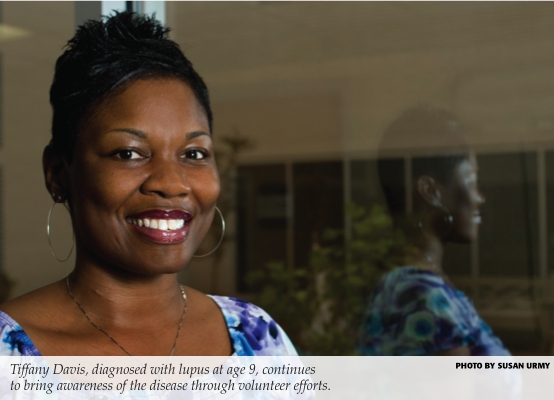Wringing out a wash cloth is considered a simple task for most people. But in
1983, at age 9, Tiffany Davis could no longer do it.
Alarmed, her mother took her to the pediatrician. They were told not to worry,
that more than likely Davis had sprained a muscle and things would be better
soon.
“But it got progressively worse,” Davis said. “I was having muscle aches and joint pain. My mother took me to Vanderbilt. They
did a blood test that showed I had lupus. I was hospitalized and missed quite a
bit of school that year. My sister, who was 11, was also diagnosed.”
The girls felt isolated.
Lupus is a chronic autoimmune disease that can damage any part of the body. It
is a disease of flares and remissions that can range from mild to
life-threatening. Estimates are that 1.5 million people in the U.S. have the
disease. Although lupus strikes primarily women of childbearing age, it can
also affect men, children and teens.
But in the 1980s there was not much available for children suffering from lupus.
“I do remember being told as a child that I would never be able to play, walk or
go outside and that I wouldn’t have a normal childhood or life,” said Davis, now 35. “Back then I thought I was the only person like me, besides my sister. You
already think you are different and feel set apart from everyone else and
having a major disease diagnosed at a young age, it made it even harder.”
Although there were no services available to the girls then, Davis made it a
point to become involved in her local branch of the Lupus Foundation as an
adult. Today she serves as a volunteer for the group raising awareness and
serving as a group facilitator since 2000.
The Lupus Foundation is one of 37 groups supported by Community Health
Charities, which is a federation of health-related organizations.
When Davis turned 23, she discovered she would need a kidney transplant because
of the damage caused by lupus. Her first transplant was done in 1999, one day
before her 25th birthday. And again five years later, she received a second
kidney transplant. It has proven to be the answer to her lupus flare-ups.
“It’s been more than 10 years since I had any issues with lupus,” said Davis, a social worker at the VA Medical Center in Nashville. “I have been fine since my first transplant. Now I deal mostly with post
transplant issues, not lupus.”
Davis also said lupus is more common than most people think.
“I know someone knows someone with lupus,” Davis said. “They just don’t know it. I challenge you to ask a person living with lupus how they manage
day-to-day and how they are affected by this disease.
“Research leads to new medications and eventually it will lead to a cure,” said Davis. “But it just takes people expressing an interest and giving. Every bit helps. It
all adds up.”



